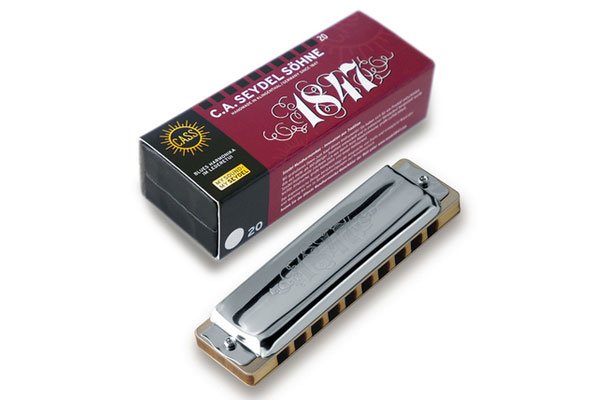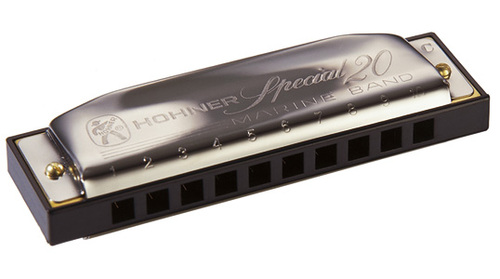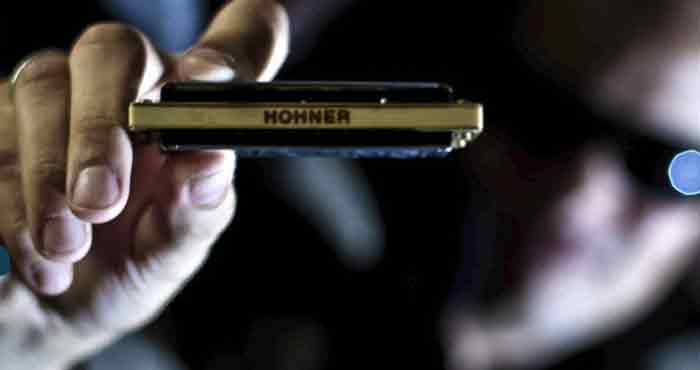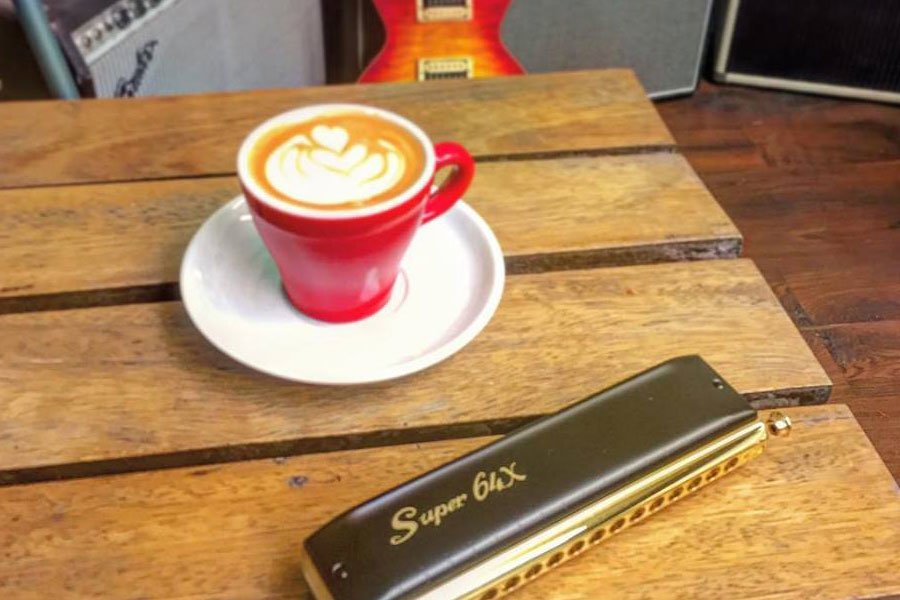432Hz Tuning – What’s all the Fuss?
The eagle-eyed of you may have noticed a slightly strange new harmonica on our website – the Seydel Classic in 432Hz tuning. So, what does this rather long-winded title mean, and should you buy one? Read on and I’ll explain.
What’s a Frequency and Why Does it Matter in Music?
Put simply, a frequency, such as 432Hz is merely the rate at which a sound vibrates through a medium – in most cases with music, a gas, unless you have a predilection for underwater listening! The Hz figure describes how many cycles the sound produces in the space of a second, so, for instance, a 432hz hum would be vibrating at 432 cycles per second. Western music divides the audible frequency range up into semitones, tones and octaves, usually by starting with a frequency, doubling it to create octaves, then evenly distributing the 11 remaining semitones throughout this octave range. This is known as equal temperament, and is not the only way to create a range of musical notes, but is the basis of tuning for many instruments, including pianos and some harmonicas. There are many other tuning systems, such as compromised (often used on harmonicas) and Pythagorean (rare these days, but more on this later), but they all have one thing in common – the need to define a starting frequency before they can create a stack of notes.
The note used in modern Western music to define the starting frequency has long been A4. This is the A note found on a a piano keyboard immediately above middle C. It is not entirely clear why A4 was chosen for this purpose (and older tuning systems, such as the Pythagorean, use alternative starting points, such as D4), but it may relate to the fact that A is a common open string on orchestral stringed instruments, making tuning to this note easier.
Thus, tuning systems will be described in terms of the frequency given to the note A4, and all other notes will be created by using a system, such as equal temperament, to ascertain their frequencies in relation to this starting point. But who defines the starting point?
A=440Hz
Between the two world wars, a group of influential musicians and physicists decided that the frequency at which orchestras were tuned needed to be standardised. Up until this point there was a whole range of different tuning standards used by various countries. France, for instance, used A4=435hz for much of the 19th Century, whilst other countries went as high as A4=450hz. Eventually, in 1950, the International Organization for Standardisation deemed A4 = 440 as “concert pitch” and this has largely been adhered to since. However, there are many players and musicians who prefer the lower tuning of A=432hz. Let’s examine why this is.
Why do some Musicians Prefer A4=432hz?
There a number of different reasons why some musicians prefer the 432hz tuning standard, ranging from the mystical to the mathematical. It’s worth noting that the origins of both of these schools of thought can be traced back to a single influence – Pythagoras.
Known to most people through his eponymous theorem, Pythagoras’s influence actually extends far beyond geometry; his school of philosophy had a fundamental influence on Christian theology, and he is credited with a system of temperament that is based on D4 =288hz (although the exact origins of this are debatable). It’s interesting to note that the Pythagoran system creates its notes via a system of pure fifths, based on what was seen as a ‘perfect’ ratio – 3/2. Now, the Pythagoreans were obsessed with the notion of the ‘perfect’ world they observed in maths, and the disparities they witnessed between the imperfections of the natural world and the perfections of geometric proofs, for instance, gave rise to the idealism of Plato and his disciples. A perfect fifth from D4=288hz gives us A=432hz, and a quasi-mystical, quasi-mathematical origin for the A=432hz tuning standard – the Pythagoreans used it! However, it should also be noted that the Pythagorean temperament does not produce many of the intervals used in modern music, such as major and minor thirds and major and minor sixths, so its influence today is, perhaps, overstated.
Another Mathematical Justification
A further maths – based justification for the superiority of A=432hz is related to the Schumann resonance – basically a measure of the spectrum peaks in an extremely low frequency portion of the Earth’s electromagnetic field – known informally as the ‘Earth’s heartbeat’. When you calculate the fundamental frequency of these waves, you reach a figure of 7.83hz, which, when rounded up to 8Hz, can be multiplied exactly into 432Hz, thus endowing the 432Hz tuning system with a vibration that is naturally in tune with the earth’s.
It may not have escaped your notice that this is a somewhat hokey bit of confirmation bias and selective rounding. You may also have noticed that 440hz, which is modern concert pitch, is also divisible exactly by 8Hz!
Other quasi-mathematicalTh justifications centre on numerology (prime number summation and the like) or relationships between the number 432 and the dimensions of celestial objects. Needless to say, cherry picking, coincidence and confirmation bias also play a significant role here, making one wonder if there really is any justification for 432Hz being superior to concert pitch, or, for that matter, any other system of tuning. However, these is one area where academic studies seem to suggest that there might be something in this 432hz business – unlikely as it seems: healing properties!
Does 432Hz Have Healing Properties?
Three studies published in peer reviewed journals, including this paper on the effects of 432Hz on anxiety show statistically significant effects of the tuning on various measures of health and wellbeing of test subjects, both human and animal. Of course, the datasets used in these studies are relatively small, and further research is necessary to fully confirm the findings and determine a causal mechanism, but these initial results do seem to suggest that justifications for 432hz are not wholly without foundation.
Can I Play With Other Musicians in 432Hz Tuning?
The short answer to this question is yes! However, there are a few complexities that mean you may not be thanked by your bandmates if you turn up to a gig with a 432Hz harmonica. Chief among these is that the band will all need to re-tune. 432Hz may not be much lower than the 440Hz that most players typically tune to, but it is enough for you to sound awful if one of you is in the lower tuning and the rest in the higher one. Try using the following online tone generator to produce notes at 440hz then at 432hz – there is a significant difference when switching between the two – something akin to a very flat or sharp vocalist performing a song! Whilst it is relatively easy for instruments such as guitars and basses to tune to 432Hz using a chromatic tuner, pianos and fixed tuning instruments, such as harmonicas, are not so easy to change.
For the same reason, you won’t be able easily to play along to songs or backing tracks apart from in the very unlikely event that the artist to whom you are listening is also utilising a 432Hz tuned instrument. Of course, you can use software applications, such as Audacity, to pitch shift existing music down to 432Hz, but this does introduce a significant new layer of complexity. How much of an issue this is to you is dependent on how much you intend to play along to existing recordings, or to what extent you are willing to play around with music production apps.
What Harmonicas are Available In 432Hz Tuning?
Standard harmonicas are tuned out of the box to somewhere between 440Hz and 443Hz. The higher of these two figures is to allow for a slight decrease in frequency when blowing or drawing hard. Pretty much any harmonica can be tuned down to 432Hz, but this is a fiddly and time consuming job that is best left to professional fettlers.
For out of the box harmonicas, Seydel is the only company to provide 432hz tuning (and, in fact, any tuning from 450Hz down to 432Hz) as an option. This is available on most of its diatonic harmonicas as a custom option, with a slight increase in price to cover the additional work required to produce the harp in 432Hz. The only harps from its current range that do not have 432Hz as an option are the entry level models with brass reeds, such as the Solist Pro and Session Standard.
We currently offer the 1847 Classic on our website, as this tends to be the most popular model from the Seydel range for this tuning. However, should you wish to order any of the available Seydel range in 432Hz, please get in touch – lead time is usually 7 working days, as these would be made to order by Seydel in Germany, and the cost will usually be around £10 – £15 more than the standard model.





Too much . its a mouth organ – just blow it and have some fun
I would be interested in this harmonica for my husband.